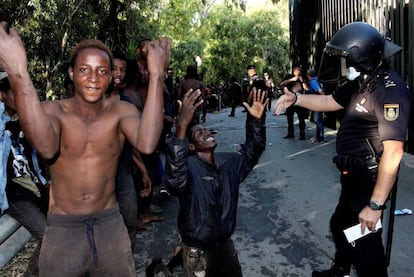Spain justifies migrant pushback in wake of large-scale jump at Ceuta
Government admits that its reception system has reached the saturation point after spike in arrivals

The Spanish Interior Ministry has defended its pushback policy on display on Thursday morning, when over 700 African migrants stormed the fence separating Morocco from Spain’s north African enclave of Ceuta.
“The Civil Guard is enforcing existing legislation,” said ministry sources about the fact that some of these migrants were immediately sent back to Morocco. The Socialist government led by Pedro Sánchez had recently said it would reconsider the controversial practice of returning migrants on the spot, but the Interior Ministry now says that “there will be no legislative change outside European agreements on immigration.”
Speaking on the SER radio network on Thursday evening, Minister Fernando Grande-Marlaska said that the migrants who were sent back to Morocco had not technically reached Spanish soil yet. His department is backing the Civil Guard’s actions on Thursday, saying officers “have to comply with the law.”

Ministry sources said that the government is “working on drafting a European common policy on immigration” and noted that making unilateral decisions “could have negative consequences.”
A record number of migrants attempted to jump over the Ceuta fence at 6.35am on Thursday, using unprecedented violence against law enforcement officers. In a release, the Civil Guard said that migrants hurled “plastic containers with excrement and quicklime, sticks and stones. Molotov cocktails were also found.”
According to the Civil Guard, 602 sub-Saharan Africans made it into Spain; 16 migrants and five officers were taken to hospital.
This latest border incident came shortly before a meeting between Pedro Sánchez and French President Emmanuel Macron to discuss the immigration crisis in Europe.
System collapse
The Spanish government is recognizing the collapse of its immigrant reception system in the wake of several large-scale arrivals in recent weeks. Also on Thursday, 300 more migrants reached the shores of Andalusia, in southern Spain, on boats from Morocco.
Spain’s interior minister said that the migrants who were sent back to Morocco had not technically reached Spanish soil
The number of undocumented migrants arriving in Spain has doubled since last year. Spain is now the main entry point into Europe, above Italy or Greece. But shelter services have been unable to keep up with the demand, leaving many migrants to sleep in overcrowded centers, police stations and even ship decks.
The European agency Frontex puts the number of arrivals between January 1 and July 15 of this year at 18,016 – 114% more than in 2017, which had already seen a 170% rise from 2016.
In the Strait of Gibraltar, shelters reached capacity on Monday after Maritime Rescue services rescued 1,000 people over the weekend and another 265 that day. On Tuesday, 334 more people arrived.
Sources familiar with Spanish-Moroccan cooperation on immigration issues on Thursday defended Rabat’s role in containing irregular immigration to Spain. “We only think about Morocco when there is a large-scale jump, but it is not news when they stop migrant arrivals by sea,” said one source. “If you consider the fact that there hadn’t been a similar incident in around six months, it means that they’ve been doing something right all this time.”
Police unions said that the border is understaffed and that officers are unable to cope with situations such as this one. “We need between 80 and 100 more officers,” said one member of the Civil Guard who patrols the border fence in Ceuta.
Ceuta center
The city of Ceuta is racing to accommodate the new arrivals at the temporary migrant reception center (CETI). It has been weeks since the government last transferred migrants from its north Africa enclaves of Ceuta and Melilla to the peninsula, because centers in Andalusia are already over capacity.
Even before the Thursday arrivals, there were already around 700 migrants at the Ceuta center, which is built for 512 people. On Thursday, army members were putting up sleeping tents in a nearby horse riding center in order to take the new immigrants there.
Unlike the migrant holding centers in the peninsula, immigrants are free to come and go from the centers in Ceuta and Melilla. “Many go down to the port for a stroll or to make a few euros helping people park their cars. They no longer go down to the city center out of fear of some people’s reaction,” said Reduan Mohammed, an activist.
English version by Susana Urra.
Tu suscripción se está usando en otro dispositivo
¿Quieres añadir otro usuario a tu suscripción?
Si continúas leyendo en este dispositivo, no se podrá leer en el otro.
FlechaTu suscripción se está usando en otro dispositivo y solo puedes acceder a EL PAÍS desde un dispositivo a la vez.
Si quieres compartir tu cuenta, cambia tu suscripción a la modalidad Premium, así podrás añadir otro usuario. Cada uno accederá con su propia cuenta de email, lo que os permitirá personalizar vuestra experiencia en EL PAÍS.
¿Tienes una suscripción de empresa? Accede aquí para contratar más cuentas.
En el caso de no saber quién está usando tu cuenta, te recomendamos cambiar tu contraseña aquí.
Si decides continuar compartiendo tu cuenta, este mensaje se mostrará en tu dispositivo y en el de la otra persona que está usando tu cuenta de forma indefinida, afectando a tu experiencia de lectura. Puedes consultar aquí los términos y condiciones de la suscripción digital.
More information
Archived In
Últimas noticias
Most viewed
- Sinaloa Cartel war is taking its toll on Los Chapitos
- Oona Chaplin: ‘I told James Cameron that I was living in a treehouse and starting a permaculture project with a friend’
- Reinhard Genzel, Nobel laureate in physics: ‘One-minute videos will never give you the truth’
- Why the price of coffee has skyrocketed: from Brazilian plantations to specialty coffee houses
- Silver prices are going crazy: This is what’s fueling the rally










































